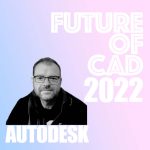The Future of CAD 2022
Time stands still for no-one – including design software – so we asked some of the leading companies in the sector, plus a couple of recent additions, for their opinions on the future of CAD, ranging from initial concepting workflows, the impact of Artificial Intelligence (AI), and even how we keep it up to date
Click on each participant below to read their full replies to all six questions in depth, or scroll down to read edited answers as they appear in the August/September issue of DEVELOP3D Magazine
 |
 |
|
 |
 |
 THE FUTURE OF CAD – AUTODESK
THE FUTURE OF CAD – AUTODESK
Ian Pendlebury
Fusion 360 VP of Engineering
How do you imagine sketch tool environments evolving?
As cloud-powered CAD becomes more prevalent and its AI capabilities more accessible, the need to define a design via sketches is giving way to describing the requirements and receiving design suggestions from the computer, taking a multitude of factors into consideration.
The computer is beginning to offer design suggestions that balance all the design requirements. For the first time, CAD is truly becoming computer aided.
Downloading regular updates to a 3D CAD package is more common – is this the way all 3D CAD is now heading?
While we see great benefits to all users being on the same cloud-powered, up-to-date, always-on version of a 3D CAD package, there are also instances where the more traditional process needs to persist, so we don’t see it going away anytime soon. Instead, we expect to continue seeing a hybrid set of offerings.
How do you view the increase in AI impacting design tools the most?
In the very short term, AI will get much better at quickly and naturally making design suggestions to a CAD user that are close to what that person would otherwise create on their own.
One example we are working on will automate the time-consuming process of creating a 2D drawing from a 3D CAD model. Machine learning will look at how a designer typically dimensions similar parts and automatically create a drawing that is very close to what that designer would likely draw.
When will CAD software be able to take advantage of modern graphics APIs for better 3D performance and advanced features like GPU ray tracing?
We are actively working on adopting USD (Universal Scene Description) and the USD Hydra rendering framework, which are fast becoming industry standards, into Fusion 360. USD is all about incredible performance through heavy use of multi-threading and GPUs.
Click here to read Ian Pendlebury’s answers in full
 THE FUTURE OF CAD – DASSAULT SYSTEMES
THE FUTURE OF CAD – DASSAULT SYSTEMES
Manish Kumar
CEO Solidworks
How do you imagine sketch tools evolving in the next few years?
There are new design workflows that are evolving where sketching is becoming less important. Two essentially sketch-less workflows are the use of direct edit methods for the reuse and/or modification of existing components, and the adoption of Sub-D modelling.
One very important workflow where sketching is evolving is in the reuse of freehand sketches, ink, or imagery as the starting point or reference for designs.
Making use of existing artwork to create sketch entities will be a great time saver for industrial designers. You can also expect to see the increasing use of AI to anticipate the needs of the user during repetitive tasks and recognise the recreation of similar sketches by dissecting past designs and automatically notify users that a very similar sketch already exists.
How do you view the increase in AI impacting design tools the most?
We have to recognise that the CAD design process can include repetitive, boring tasks. We see AI playing a huge role in augmenting a designer’s workflows by carrying out mundane repetitive tasks, freeing up time to be more creative.
Browser-based tools in 3D Creator, 3D SheetMetal Creator, and 3D Sculptor have AI-based Design Assistants built into them. Machine learning algorithms learn from the way the user designs and reduces or automates repetitious tasks, such as selecting edges, inserting mates, or predicting new sketch entities and giving users an option to insert them automatically.
How do you imagine the users of your software will change and how do you see this impacting the software?
Today 3D has been democratised to the point that it has become a universal language to collaborate and share ideas between all age groups and geographies.
It is no longer just about providing a product, but also delivering a great experience around this – it must be aesthetically pleasing, reliable, robust, and perform well during regular use.
Click here to read Manish Kumar’s answers in full
 THE FUTURE OF CAD – PHENOMETRY
THE FUTURE OF CAD – PHENOMETRY
Stephanos Androutsellis-Theotokis
Co-Founder & Senior software developer
How do you imagine sketch tool environments evolving?
Browser-based collaboration will definitely play an important role. Google Docs-style collaboration tools have already been adopted by major CAD software such as Onshape, allowing their users to interact and collaborate with each other on shared documents, while at the same time reaping the benefits of behind-the-scenes updates.
How do you imagine designers will interact with CAD UIs in the future?
It’s high time that CAD UIs moved away from countless huge menus with items and subitems that users need to spend a lot of time memorising.
Advanced gestures, touchscreens, and more direct interaction with the model are key for a more intuitive user experience. Constant, non-obtrusive feedback on what is expected to complete the current operation and what the current options are help guide the user and reduce their cognitive load.
Will all 3D CAD rely on OTA updates, or will annual releases and standalone products manage to survive?
While there is still wide use of standalone products, the shift towards cloud-based benefits is clear and irreversible. No one enjoys the overheads incurred by downloading updates, installing them and making sure nothing clashes or breaks.
Similarly, a fully cloud-based CAD software product vendor doesn’t have to worry about multiple platform compatibility, system issues or have to maintain countless code branches for each version or platform.
How do you imagine the users of your software will change and how do you see this impacting the software?
We think digital innovative design tool use is going to reach significantly more users in the next few years, with products that are easy to use and have sharing and collaboration capabilities being significantly favoured.
Phi’s architecture and approach to freeform modelling were designed with the above in mind, so the software can cope with a wide range of users.
Click here to read Stephanos Androutsellis-Theotokis’ answers in full
 THE FUTURE OF CAD – PTC
THE FUTURE OF CAD – PTC
Jay Tedeschi
Product Management Principal, Onshape
Downloading regular updates to a 3D CAD package is more common – is this the way all 3D CAD is now heading?
To some degree, almost all vendors now supply their users with hotfixes/updates between major releases. What we can say is that Onshape’s full SaaS implementation means that Onshape users do not have to deal with product downloads, installations or updates.
How do you imagine the users of your software will change and how do you see this impacting the software?
For a generation of users well versed with collaborative applications, Onshape is one more tool that leverages this familiar paradigm. The fact that it is a design and engineering tool becomes secondary to how they interact with it and with others using it.
For users who have spent a career using more traditional file-based systems, the transition to these tools is more of a philosophical change than anything else.
This subset of users quickly sees the advantages of working with these new tools once overcoming their initial resistance to adopting this new way of interacting with both design data and design team members
How do you view the increase in AI impacting design tools the most?
We feel that one of the strongest uses of AI is in areas of the product which are typically not considered when discussing AI as a design tool aid. As a full SaaS/Cloud native product, Onshape can compile data about not only how the product is being used, but also how effectively it is running on a specific network, on a specific server, at certain times, with certain traffic, and so on.
All of that information can then be analysed and development decisions made in response to the data. This promises to have a much larger impact overall on user productivity than just the current implementations.
Click here to read Jay Tedeschi’s answers in full
 THE FUTURE OF CAD – SHAPR3D
THE FUTURE OF CAD – SHAPR3D
Istvan Csanady
CEO
How do you imagine designers will interact with CAD UIs in the future?
Touch and stylus is a more natural and often faster way to use a CAD system than a keyboard and a mouse. The only thing that could be even more natural is a well-designed AR or VR experience, which is something that still belongs to the future.
Downloading regular updates to a 3D CAD package is more common – is this the way all 3D CAD is now heading?
The truth is that CAD is just a piece of software like any other software.
It doesn’t need to be clumsy and fragile – it’s only like that because legacy CAD companies are building software like they did in the 1990’s and their customers are suffering from those obsolete practices. It’s time to change that.
How do you imagine the users of your software will change and how do you see this impacting the software?
I believe that accessing CAD will not be a privilege of a small, highly trained group of engineers, but it will become a tool that all stakeholders can access.
For designing, reviewing, conceptualising, collaborating, prototyping, and manufacturing – all stakeholders will be able to use the same design platform in the future.
New generations of CAD users expect their software to be accessible across different devices: they want an equally great mobile and desktop experience. Consumer-grade usability and accessibility of software is a basic expectation, not just a gimmick.
Legacy CAD companies are having a tough time adapting to this tectonic shift in customer expectations.
When will CAD software be able to take advantage of modern graphics APIs for better 3D performance and advanced features like GPU ray tracing?
Well, Shapr3D already does and will do even more, but I can’t talk about that just yet!
Click here to read Istvan Csanady’s answers in full
 THE FUTURE OF CAD – SIEMENS
THE FUTURE OF CAD – SIEMENS
Paul Brown
Senior Marketing Director, Product Engineering Software
How do you imagine sketch tool environments evolving?
We have been employing AI to help remove the need for the user to predefine the rules and constraints, finding and implying them at the time of edit without forcing the user to do the work. This makes sketching far more flexible, and faster for doing initial design studies and concepts.
This approach allows people to think about what they want to create rather than trying to battle with rules or constraints.
How do you imagine designers will interact with CAD UIs in the future?
New approaches such as voice are beginning to break through. Using voice and cognitive services allows you to drive CAD commands using natural language, freeing the user from having to speak CAD, being able to say, ‘have I got anything similar?’ instead of ‘Shape Search’, makes it easier for users to get more from their systems – no searching for file names or icons.
NX Voice Assistant uses Microsoft cognitive services to allow users to drive NX and increase productivity.
How do you view the increase in AI impacting design tools the most?
The use of Machine Learning and Artificial Intelligence will have a massive impact on making it more productive for users to use CAD tools, having systems that can learn and promote best practice from power users and have that knowledge shared around an organisation delivers massive benefits.
The future for AI will see it expanding to offer more help and advise users in design decisions, acting as a support for choices in design.
Areas like Generative Engineering opens more opportunities to use AI to help, advise and learn, doing rapid design iterations automatically, increasing use of AI in this area will help based tools helping engineers make better decisions faster.






